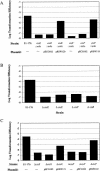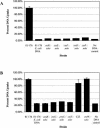Natural transformation of Campylobacter jejuni requires components of a type II secretion system
- PMID: 12949093
- PMCID: PMC193740
- DOI: 10.1128/JB.185.18.5408-5418.2003
Natural transformation of Campylobacter jejuni requires components of a type II secretion system
Erratum in
- J Bacteriol. 2003 Nov;185(21):6493
Abstract
The human pathogen Campylobacter jejuni is one of more than 40 naturally competent bacterial species able to import macromolecular DNA from the environment and incorporate it into their genomes. However, in C. jejuni little is known about the genes involved in this process. We used random transposon mutagenesis to identify genes that are required for the transformation of this organism. We isolated mutants with insertions in 11 different genes; most of the mutants are affected in the DNA uptake stage of transformation, whereas two mutants are affected in steps subsequent to DNA uptake, such as recombination into the chromosome or in DNA transport across the inner membrane. Several of these genes encode proteins homologous to those involved in type II secretion systems, biogenesis of type IV pili, and competence for natural transformation in gram-positive and gram-negative species. Other genes identified in our screen encode proteins unique to C. jejuni or are homologous to proteins that have not been shown to play a role in the transformation in other bacteria.
Figures





Similar articles
-
Transposon mutagenesis of Campylobacter jejuni identifies a bipartite energy taxis system required for motility.Mol Microbiol. 2001 Apr;40(1):214-24. doi: 10.1046/j.1365-2958.2001.02376.x. Mol Microbiol. 2001. PMID: 11298288
-
Systematic identification of genetic loci required for polymyxin resistance in Campylobacter jejuni using an efficient in vivo transposon mutagenesis system.Foodborne Pathog Dis. 2009 Mar;6(2):173-185. doi: 10.1089/fpd.2008.0177. Foodborne Pathog Dis. 2009. PMID: 19105633
-
Identification of potential Campylobacter jejuni genes involved in biofilm formation by EZ-Tn5 Transposome mutagenesis.BMC Res Notes. 2017 May 12;10(1):182. doi: 10.1186/s13104-017-2504-1. BMC Res Notes. 2017. PMID: 28499399 Free PMC article.
-
DNA transport during transformation.Front Biosci. 2003 May 1;8:s544-56. doi: 10.2741/1047. Front Biosci. 2003. PMID: 12700070 Review.
-
From isotopically labeled DNA to fluorescently labeled dynamic pili: building a mechanistic model of DNA transport to the cytoplasmic membrane.Microbiol Mol Biol Rev. 2024 Mar 27;88(1):e0012523. doi: 10.1128/mmbr.00125-23. Epub 2024 Mar 11. Microbiol Mol Biol Rev. 2024. PMID: 38466096 Free PMC article. Review.
Cited by
-
ComFC mediates transport and handling of single-stranded DNA during natural transformation.Nat Commun. 2022 Apr 12;13(1):1961. doi: 10.1038/s41467-022-29494-z. Nat Commun. 2022. PMID: 35414142 Free PMC article.
-
Genomic diversity, virulence and source of Campylobacter jejuni contamination in Irish poultry slaughterhouses by whole genome sequencing.J Appl Microbiol. 2022 Nov;133(5):3150-3160. doi: 10.1111/jam.15753. Epub 2022 Aug 22. J Appl Microbiol. 2022. PMID: 35993276 Free PMC article.
-
A Chaperone for the Stator Units of a Bacterial Flagellum.mBio. 2019 Aug 6;10(4):e01732-19. doi: 10.1128/mBio.01732-19. mBio. 2019. PMID: 31387912 Free PMC article.
-
A Campylobacter jejuni znuA orthologue is essential for growth in low-zinc environments and chick colonization.J Bacteriol. 2009 Mar;191(5):1631-40. doi: 10.1128/JB.01394-08. Epub 2008 Dec 19. J Bacteriol. 2009. PMID: 19103921 Free PMC article.
-
Viscosity-dependent determinants of Campylobacter jejuni impacting the velocity of flagellar motility.mBio. 2024 Jan 16;15(1):e0254423. doi: 10.1128/mbio.02544-23. Epub 2023 Dec 12. mBio. 2024. PMID: 38085029 Free PMC article.
References
Publication types
MeSH terms
Substances
Associated data
- Actions
- Actions
LinkOut - more resources
Full Text Sources

